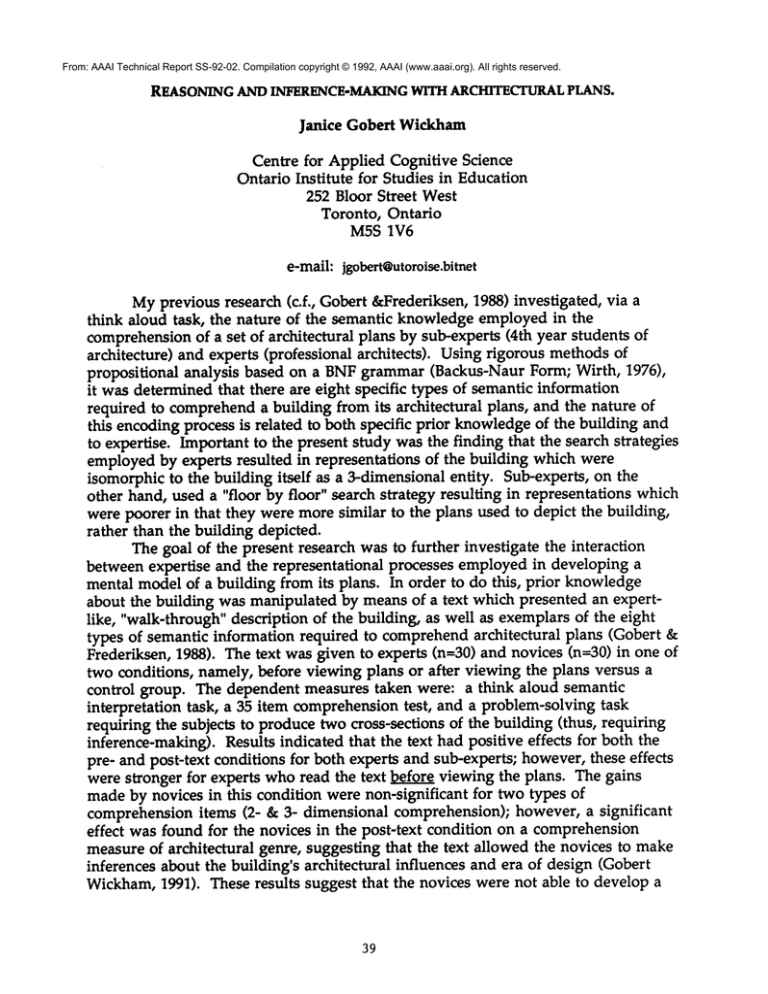
From: AAAI Technical Report SS-92-02. Compilation copyright © 1992, AAAI (www.aaai.org). All rights reserved.
REASONINGAND INFERENCE-MAKING
WITH ARCHITECTURAL
PLANS.
Janice
Gobert Wickham
Centre for Applied Cognitive Science
Ontario Institute for Studies in Education
252 Bloor Street West
Toronto, Ontario
M5S 1V6
e-mail: jgobert@utoroise.bitnet
Myprevious research (c.f., Gobert &Frederiksen, 1988) investigated, via
think aloud task, the nature of the semantic knowledge employed in the
comprehension of a set of architectural plans by sub-experts (4th year students of
architecture) and experts (professional architects).
Using rigorous methods
propositional
analysis based on a BNF grammar (Backus-Naur Form; Wirth, 1976),
it was determined that there are eight specific types of semantic information
required to comprehend a building from its architectural
plans, and the nature of
this encoding process is related to both specific prior knowledge of the building and
to expertise. Important to the present study was the finding that the search strategies
employed by experts resulted in representations
of the building which were
isomorphic to the building itself as a 3-dimensional entity. Sub-experts, on the
other hand, used a "floor by floor" search strategy resulting in representations which
were poorer in that they were more similar to the plans used to depict the building,
rather than the building depicted.
The goal of the present research was to further investigate the interaction
between expertise and the representational
processes employed in developing a
mental model of a building from its plans. In order to do this, prior knowledge
about the building was manipulated by means of a text which presented an expertlike, "walk-through" description of the building, as well as exemplars of the eight
types of semantic information required to comprehend architectural
plans (Gobert
Frederiksen, 1988). The text was given to experts (n=30) and novices (n=30) in one
two conditions, namely, before viewing plans or after viewing the plans versus a
control group. The dependent measures taken were: a think aloud semantic
interpretation
task, a 35 item comprehension test, and a problem-solving task
requiring the subjects to produce two cross-sections of the building (thus, requiring
inference-making). Results indicated that the text had positive effects for both the
pre- and post-text conditions for both experts and sub-experts; however, these effects
were stronger for experts who read the text before viewing the plans. The gains
made by novices in this condition were non-significant for two types of
comprehension items (2- & 3- dimensional comprehension); however, a significant
effect was found for the novices in the post-text condition on a comprehension
measure of architectural
genre, suggesting that the text allowed the novices to make
inferences about the building’s architectural influences and era of design (Gobert
Wickham, 1991). These results suggest that the novices were not able to develop
39
comprehensive mental model of the building from the text, whereas, experts were
able to make use of both types of information given (text and graphics) in order
develop a comprehensive mental model of the building, presumably by applying
search, recognition, and inference operators (Larkin & Simon, 1987) on both the
textual information as well as the graphic information sources (i.e., architectural
plans) they were given. The data (analysis is on-going) will be discussed in terms
the benefits which the text afforded in: 1) directing search through the architectural
plans; 2) facilitating
inferences about the building, and 3) the interaction between the
knowledge acquisition process (from text + graphics) with expertise in this domain.
REFERENCES
Gobert, J. & Frederiksen, C. (1988). The comprehension of architectural
plans by expert
and sub-expert architects.
Proceedings of the Tenth Annual Meeting of the
Cognitive Science Society. Montreal, Canada. Hillsdale, N.J.: Lawrence Erlbaum.
Gobert Wickham, J. (1991). The use of textual organizers to enhance the
comprehension of graphic information. Canadian Psychology. vol 32(2a). p. 381.
Larkin, J. & Simon, H. (1987). Whya diagram is (sometimes) worth 10,000 words:
Co enitive Science, 11, 65-99.
Wirth, N. (1976). Algorithms + Data Structures
Prentice-Hall.
40
= Programs. Englewood Cliffs,
NJ:


